Transcending Clearance: Development gaps post-UXO clearance vs. agricultural reclamation in Laos
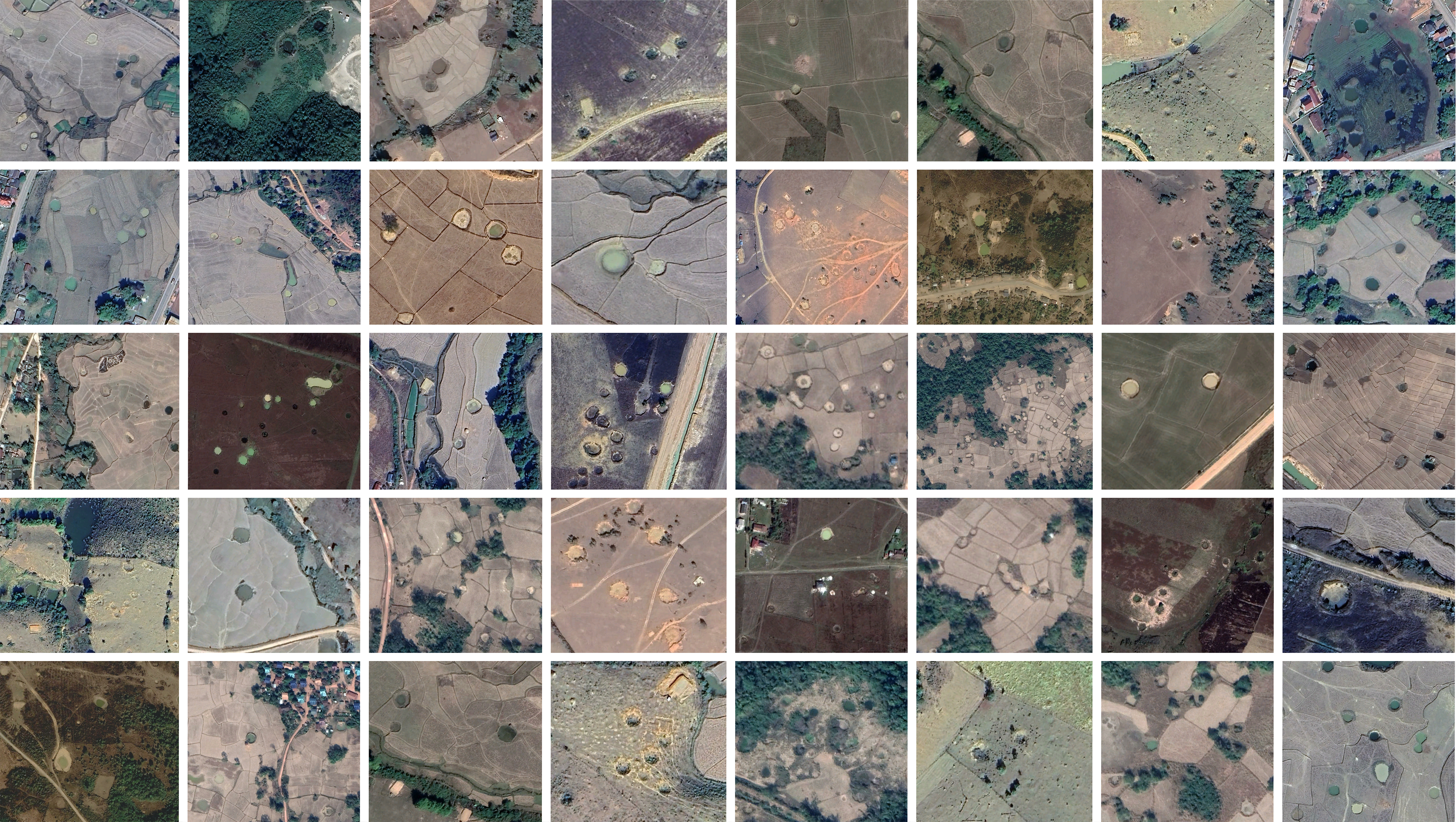
Crater, Satellite images by Google Earth
Acronyms
CCM Convention on Cluster Munitions
CHA Confirmed Hazardous Areas
CMR Cluster Munition Remnants
CMRS Cluster Munition Remnants Survey
EOD Explosive ordnance disposal
EORE Explosive ordnance risk education
HALO Hazardous Area Life-support Organization
HI Humanity & Inclusion
MAG Mines Advisory Group
NGO Non-governmental organization
NPA Norwegian People’s Aid
NRA National Regulatory Authority for UXO/Mine Action Sector in Lao PDR
SDG Sustainable Development Goal
UNDP United Nations Development Programme
UXO Unexploded ordnance
Abstract
Throughout the Vietnam War, the United States dropped as many as 260 million cluster bombs on Laos, equivalent to a bombing mission every eight minutes for nine years. By the end of the war, approximately 80 million bombs remained undetonated. It has been threatening the lives and property of the Lao people for 50 years. Laos is a country whose economy is heavily dependent on agriculture, and the buried bombs have seriously hampered the country’s agricultural development. Therefore, since 1996, Laos has worked with global assistance to clear these remnants of war, with 78% of the cleared land repurposed for agriculture between 1997 and 2022. Worth noting is - financial resources, technical support, and government policies are solely directed toward bomb clearance projects in Laos, leading to insufficient investment and support in post-clearance endeavors. With limited resources allocated to rehabilitating cleared (or possibly incompletely cleared) farmland, agricultural restoration largely relies on farmers independently. This research delves into the ongoing challenges and barriers between cluster bomb clearance and cropland revitalization, highlighting the need for increased international support to bridge this critical gap.
Background
The U.S. bombed Laos during the Vietnam War to disrupt North Vietnamese supply routes through Laos along the Ho Chi Minh Trail and to combat communist forces operating in the area. This intense bombing campaign, spanning from 1964 to 1973, dropped up to 260 million cluster bombs, making Laos the most bombed country per capita in history. The military operations used a large number of cluster bombs because these bombs can release a large number of smaller bomblets over a large area, and not all of the bomblets will explode when dropped. By the end of the war, 30% (about 80 million pieces) of UXOs could remain active under the ground.
Theater History of Operations (THOR) Data: Vietnam War
Data source: https://data.world/datamil/vietnam-war-thor-data
UXO Threat Today
For five decades, UXOs has persistently threatened the livelihoods and safety of the population. Lao is a nation heavily reliant on agriculture, especially in remote mountainous areas with low population density, many of which have more than 90 percent of the total land used for agriculture. According to the Food and Agriculture Organization/World Food Program Joint Report, as of November 2022, approximately 13.9% of people in Laos are experiencing moderately severe food insecurity, and 0.9% are experiencing severe acute food insecurity.
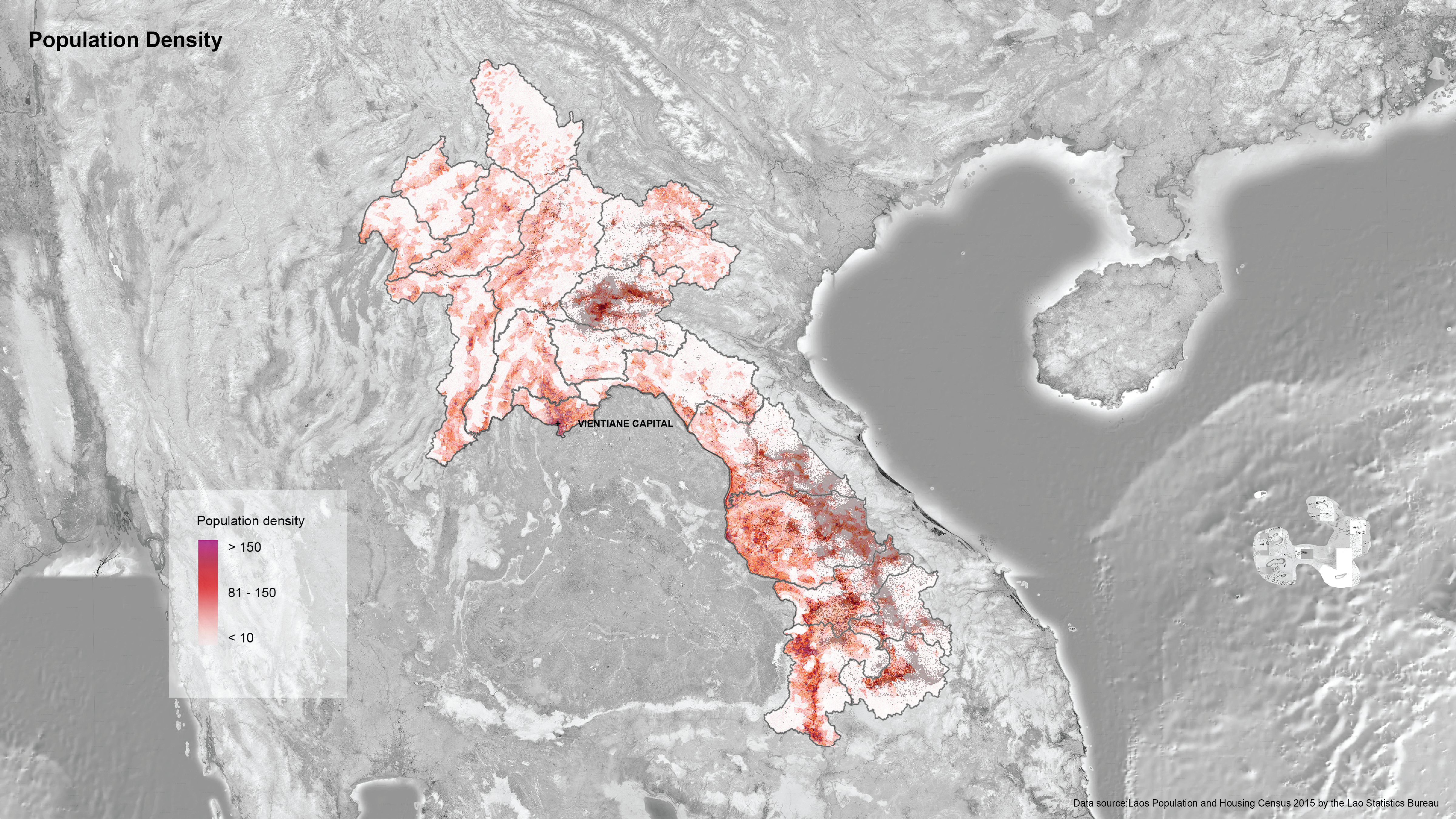
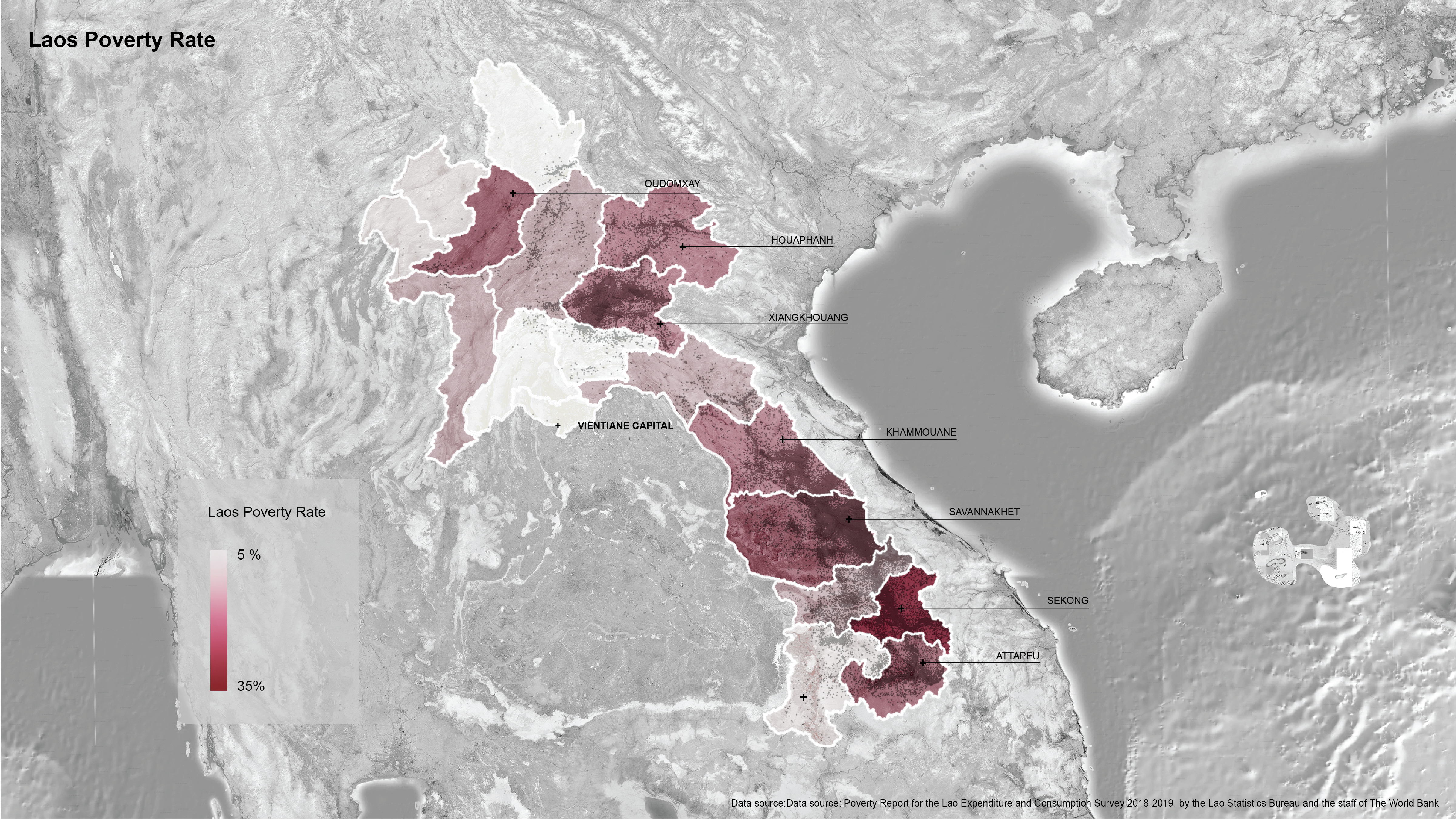


Black dots represent bomb drop points
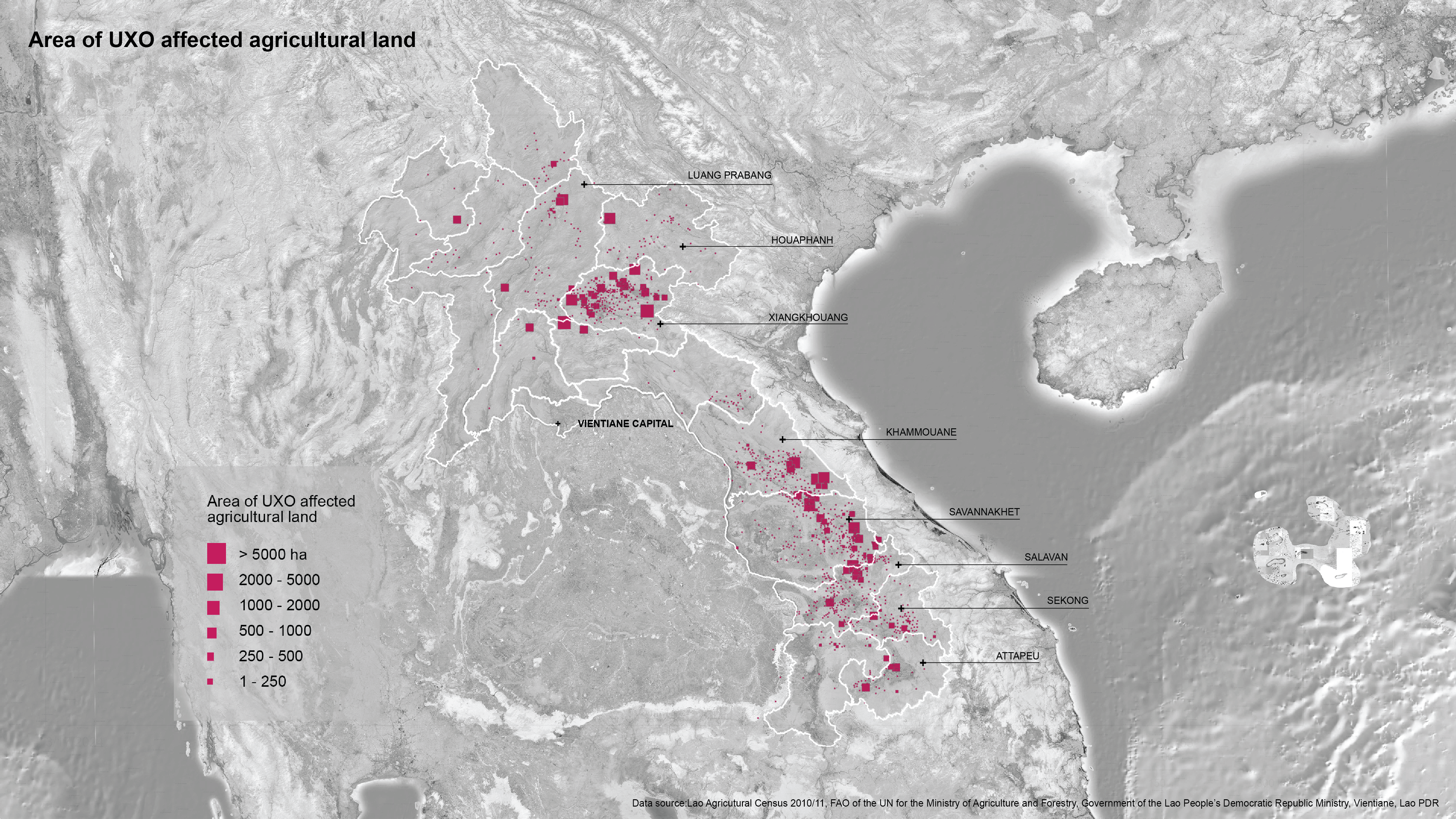
As the Landmine and Cluster Munition Monitoring Agency estimates, approximately 29,000 people, mostly civilians, have died as a result of bombing accidents. Farmers engaged in agricultural production are the most victimized group. Since UXOs scattered on agricultural land poses an ongoing risk, as farmers often inadvertently detonate bombs during agricultural activities, which directly contributes to farmers’ fear of agricultural activities and the need to abandon fertile agricultural land. These risks curtail agricultural productivity, limit the continuation of economic downturns, and deepen food insecurity.

Data source: Soulineyadeth, Sopha. “Impact of Unexploded Ordnance (UXO) on Rural Communities‘ Livelihoods in Xiengkhouang Province, Lao PDR.” (2014)., 2022 Food and Agriculture Organisation/World Food Program Joint Report, The Landmine and Cluster Munition Monitoring Agency
Ongoing Clearance
Mitigating UXO’s effects on agricultural productivity is essential to addressing food insecurity in Laos. Therefore, since 1996, Laos initiated a cleanup effort for unexploded bombs, supported by countries globally. As of now, around 60,343 hectares of farmland have been cleared and restored, benefiting over 5,123,174 individuals. Financial aid from nations like the United States, Japan, Norway, Canada, and others has facilitated this progress. Notably, the United States has been a significant contributor, having invested over $335 million in UXO clearance operations since 1995, as stated by Heather Variava, the US Ambassador to Laos.
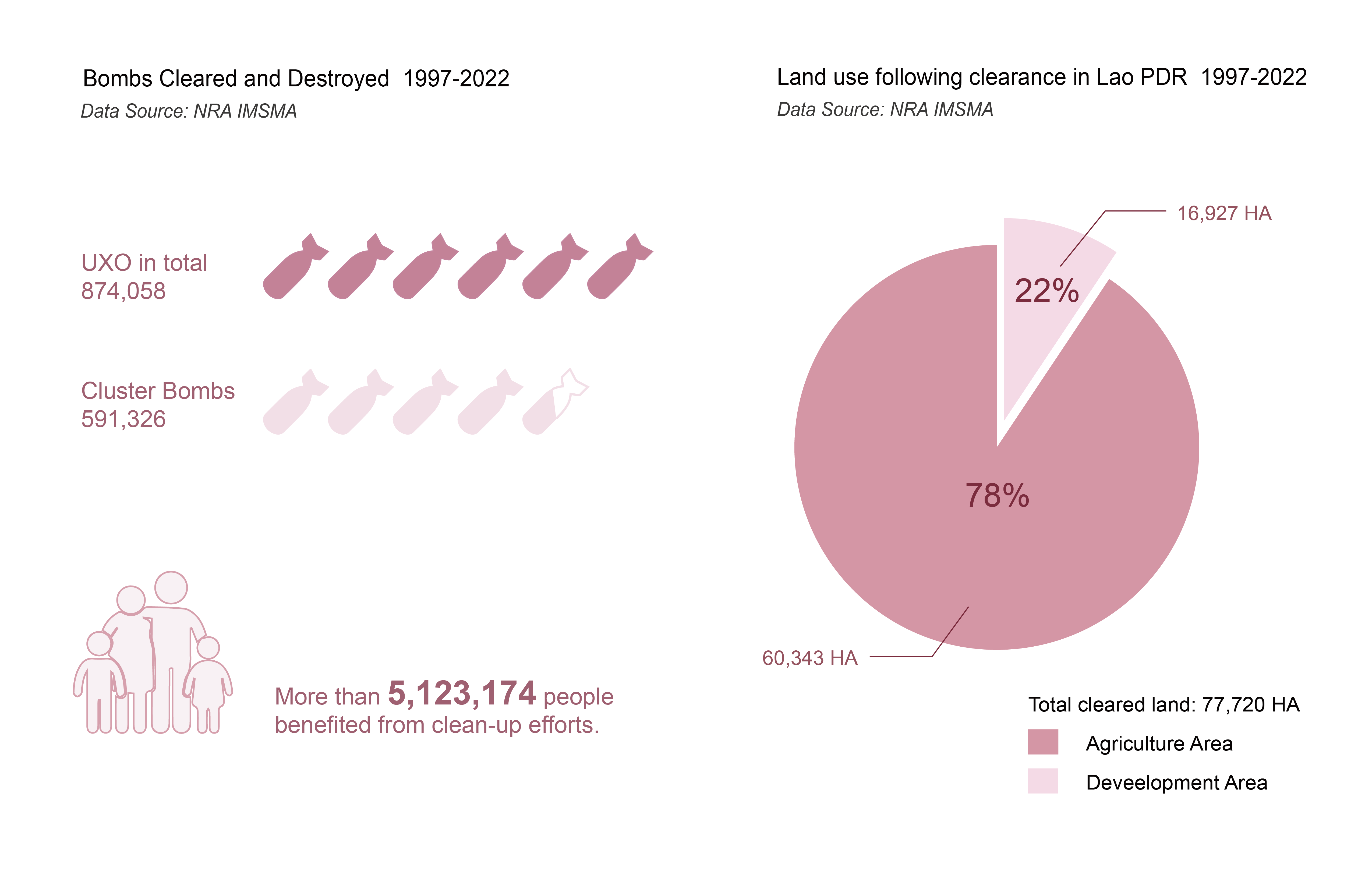
Beginning in 2015, in order to better guide cleanup operations and improve clearance progress, cleanup operators in Laos worked closely to develop a technical survey method called Cluster Munition Remains Survey (https://www.mineactionstandards.org/standards/08-20-02/). By enlisting the help of village-level organizations and leveraging villagers’ records, the identification and removal of unexploded bombs have become more precise, thus enhancing overall work efficiency.

Neglected Sector
The clearance efficiency is picking up speed, but there is a lack of assistance and support for post-clearance, especially actions aimed at agricultural restoration. Katarina Cvikl Balić’s discussion in “Clear then Grow: Integrating Mine Action with Food Security in Northeast Syria,” underscores the focus on addressing contamination and financial constraints in the designated operational zones through an agricultural recovery plan. This approach involves empowering farmers with essential tools, seeds, and knowledge, facilitating the sustainable development of small-scale agricultural businesses. In Laos, clearance projects prioritize high-priority land releases for effective coordination and monitoring of UXO/mine action initiatives, aligning with Sustainable Development Goal 18 and CCM compliance. According to the 2022 UXO Sector Annual Report, the annual financial allocation of large organizations like MAG, HALO, HI, and NPA is about 67% of total operational financial expenditures for bomb survey and clearance, about 1% for victim assistance, and about 1.2% for EORE, with no specific financial allocation and assistance for post-clearance activities. This results in insufficient support for UXO operational deployments, hindering village-level agriculture recovery and leaving farmers to face challenges alone.
Their stories
In addition to the lack of support for post-clearance scenarios from high-level entities such as international and national organizations, there are shortcomings in information delivery and assistance to grassroots communities, especially the lack of consistent communication between the investigation team and villagers during the investigation process. After cleanup, most households will receive documents outlining the tasks performed, and GPS coordinates of the cleared area, according to the United Nations Development Programmer’s 2023 post-clearance impact assessment. The technical documents were too complex for villagers to grasp fully. As a result, they remain unaware of which lands have been cleared, to what extent, and whether they’re suitable for farming. The lack of information dissemination at the grassroots level further hinders the speed of agricultural recovery and aggravates the obstacles to agricultural development.

Conclusion
For Laos, the clearance of UXO holds immense significance for advancing agricultural development, fostering economic growth, and tackling challenges like food insecurity. However, the current clearance framework lacks recognition and assistance for agricultural rehabilitation, leaving farmers, particularly smallholders, to continue to face hardships. Hence, this study emphasizes the necessity of adopting a more comprehensive approach post-clearance, including supporting farmers’ productive activities and providing financial assistance as a pivotal focus for the subsequent phases of UXO clearance.
Reference
Ounmany, K. (2021). Impacts of Unexploded Ordnance Clearance on Wet Rice Farming in Xieng Khouang Province, Northern Laos. Journal of Peacebuilding & Development, 16(3), 372-376. https://doi.org/10.1177/1542316621989233
Howe, Brendan, and Kearrin Sims. “Human Security and Development in the Lao PDR: Freedom from Fear and Freedom from Want.” Asian Survey, vol. 51, no. 2, 2011, pp. 333–55. JSTOR, https://doi.org/10.1525/as.2011.51.2.333. Accessed 22 Mar. 2024.
“Clear Then Grow: Integrating Mine Action with Food Security in Northeast Syria.” Www.jmu.edu, www.jmu.edu/news/cisr/2022/10/261-2/06-261-balic.shtml. Accessed 29 Apr. 2024.
Lapuekou, Chono. “United States Provides over USD 24 Million for UXO Clearance in Laos.” Laotian Times, 5 Mar. 2024, laotiantimes.com/2024/03/05/united-states-provides-over-usd-24-million-for-uxo-clearance-in-laos/#:~:text=According%20to%20the%20Ambassador%2C%20the. Accessed 29 Apr. 2024.
2022 UXO SECTOR ANNUAL REPORT, The National Regulatory Authority for UXO/Mine Action in Lao PDR (NRA) and the UXO Unit of the United Nations Development Programme (UNDP) in Lao People’s Democratic Republic (Lao PDR)
FINAL REPORT: Post-Clearance Impact Assessment for UNDP’s UXO Clearance Support, United Nations Development Programme
Poverty Profile in Lao PDR : Poverty Report for the Lao Expenditure and Consumption Survey 2018-2019 (English). Washington, D.C. : World Bank Group. http://documents.worldbank.org/curated/en/685131623647655386/Poverty-Profile-in-Lao-PDR-Poverty-Report-for-the-Lao-Expenditure-and-Consumption-Survey-2018-2019
Lao Agricutural Census 2010/11, FAO of the UN for the Ministry of Agricuture and Forestry Government of the Lao People’s Democratic Republic Ministry, Vientiane, Lao PDR
Laos Population and Housing Census 2015, The Lao Statistics Bureau
UXO VICTIMS National UXO Victims and Accidents Surveyhttps://www.uxolao.org/uxo-victims/
http://www.nra.gov.la/resources.php
https://data.opendevelopmentmekong.net/dataset/125d72a8-086f-48ff-980f-a396d590a839/resource/461fe954-ffaa-474a-94f1-ee6d898a92b2/download/nra-phase-1-va-report-final.pdf
http://archives.the-monitor.org/index.php/publications/display act=submit&pqs_year=2000&pqs_type=lm&pqs_report=lao&pqs_section=
https://the-monitor.org/en-gb/MonitorSearch?year=0&report=§ion=&country=Lao%20PDR
